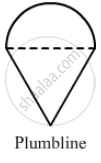Advertisements
Advertisements
Question
How many cubes of 10 cm edge can be put in a cubical box of 1 m edge?
Solution
We have,
Edge of the cube, a = 10 cm and
Now,
The number of cubes that can be put in the box `= ("Volume of the cubical box")/"Volume of the cube"`
`="l"^3/"a"^3`
`=100^3/10^3`
= 103
= 1000
so the number of cubes that can be put in the cubical box is 1000.
APPEARS IN
RELATED QUESTIONS
A cubical block of side 10 cm is surmounted by a hemisphere. What is the largest diameter that the hemisphere can have? Find the cost of painting the total surface area of the solid so formed, at the rate of Rs. 5 per 100 sq. cm. [Use π = 3.14]
504 cones, each of diameter 3.5 cm and height 3 cm, are melted and recast into a metallic sphere. Find the diameter of the sphere and hence find its surface area.
[Use π=22/7]
A hemispherical depression is cut out from one face of a cubical wooden block such that the diameter l of the hemisphere is equal to the edge of the cube. Determine the surface area of the remaining solid.
A bucket made of aluminum sheet is of height 20cm and its upper and lower ends are of radius 25cm an 10cm, find cost of making bucket if the aluminum sheet costs Rs 70 per
100 cm2
Find the number of metallic circular discs with 1.5 cm base diameter and of height 0.2 cm to be melted to form a right circular cylinder of height 10 cm and diameter 4.5 cm .
A solid metallic sphere of diameter 21 cm is melted and recast into a number of smaller cones, each of diameter 3.5 cm and height 3 cm. Find the number of cones so formed.
Five identical cubes, each of edge 5 cm, are placed adjacent to each other. Find the volume of the resulting cuboid.
A plumbline (sahul) is a combination of

If the surface areas of two spheres are in ratio 16 : 9, then their volumes will be in the ratio ______.
If the volumes of a cube is 1728 cm³, the length of its edge is equal to ______.
